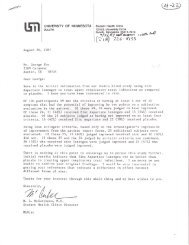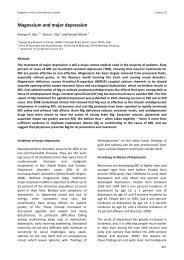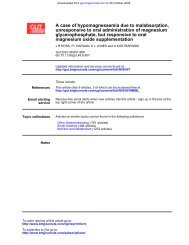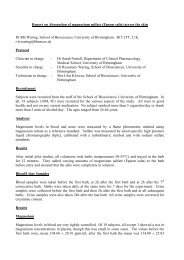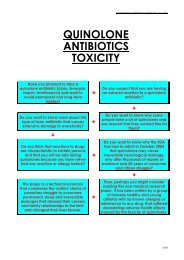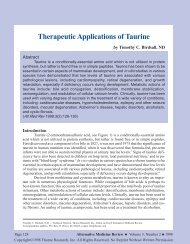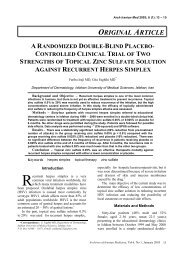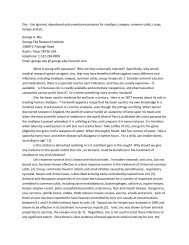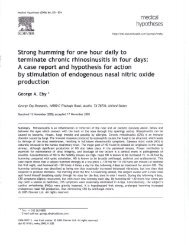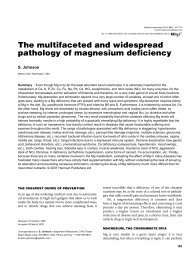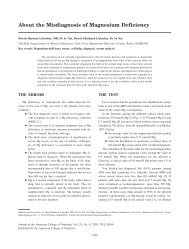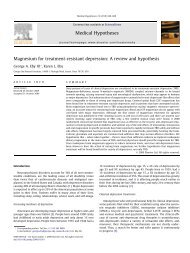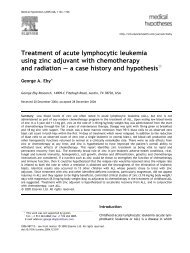Therapeutic Gallium Compounds - George Eby Research Institute
Therapeutic Gallium Compounds - George Eby Research Institute
Therapeutic Gallium Compounds - George Eby Research Institute
Create successful ePaper yourself
Turn your PDF publications into a flip-book with our unique Google optimized e-Paper software.
14 31 Ga <strong>Therapeutic</strong><br />
<strong>Gallium</strong> <strong>Compounds</strong><br />
Lawrence R. Bernstein<br />
14.1 Introduction<br />
<strong>Gallium</strong> was described before it was ever observed. This bold feat was accomplished<br />
by Dmitri Mendeleev, 1 who in 1871 postulated that ‘eka-aluminum’<br />
would fill the gap below aluminum in his newly created periodic table of the<br />
elements, and would chemically resemble its neighbor. The element was actually<br />
discovered in 1875 by Paul-Émile Lecoq de Boisbaudran, not in association<br />
with aluminum, but rather as a trace element in sphalerite (zinc sulfide) from<br />
southern France. Lecoq de Boisbaudran named the element gallium ‘in honor<br />
of France (Gallia)’, 2 though there have been lingering suspicions that the name<br />
also may be derived from ‘gallus,’ Latin for ‘le coq’ (rooster).<br />
The first published investigation of gallium’s therapeutic potential was that<br />
by Levaditi et al. in 1931. 3 <strong>Gallium</strong> tartrate eradicated experimental syphilis in<br />
rabbits with a single dose of 30–45 mg Ga/kg intramuscularly or 15 mg Ga/kg<br />
intravenously. At 225 mg Ga/kg it was found to eliminate infection by Trypanosoma<br />
evansi in mice. Despite the reported efficacy and lack of toxicity<br />
(750 mg Ga/kg was tolerated in mice), there was no published follow-up to this<br />
research over the next several decades.<br />
A period of intensive research on the toxicity and tissue distribution of gallium<br />
occurred from about 1949 to 1952. The earliest of these studies showed that<br />
Metallotherapeutic Drugs and Metal-Based Diagnostic Agents: The Use of Metals in Medicine<br />
Edited by Gielen and Tiekink Ó 2005 John Wiley & Sons, Ltd
260 <strong>Therapeutic</strong> <strong>Gallium</strong> <strong>Compounds</strong><br />
gallium was poorly absorbed from oral ingestion of common gallium salts or<br />
chelates, 4 and that injected gallium (generally as the citrate) tended to concentrate<br />
in bone, liver and kidney tissue. 5 Attention quickly turned to gallium radioisotopes,<br />
particularly 72 Ga, as these could be easily used to trace the distribution of<br />
gallium in experimental animals and humans. 6 Radiogallium was soon found to<br />
concentrate in regions of high bone turnover, particularly in some bone tumors. 7<br />
Based on these findings, a preclinical and clinical study (34 patients) was<br />
undertaken to explore the use of radioactive 72 Ga to treat primary and metastatic<br />
bone cancers. 8 The guiding hypothesis was that 72 Ga would become<br />
highly concentrated in tumors, which would then be destroyed by the localized<br />
radiation. Results indicated that due to its short half-life (14.1 h), by the time<br />
the 72 Ga became concentrated in the target tumors, the radiation level had<br />
already decreased so much as to be ineffective, while the patient had been<br />
subjected to undesirable levels of whole body radiation. 8 In addition, since<br />
72 Ga was produced by neutron irradiation of stable 71 Ga, from which it could<br />
not be chemically separated, 72 Ga was by necessity administered with large<br />
amounts of non-radioactive ‘carrier’ gallium, which was felt to pose a toxicity<br />
risk. The use of non-radioactive gallium as a therapeutic agent was apparently<br />
not contemplated at this time, and no further work on the potential therapeutic<br />
use of gallium appeared until the 1970s. The studies of the early 1950s did,<br />
nevertheless, produce data on gallium tissue distribution in experimental animals<br />
and humans, and ultimately led to the now widespread use of radioactive<br />
gallium (mainly 67 Ga, with a half-life of about 78 h) as a diagnostic agent for<br />
some cancers, infections and inflammatory diseases.<br />
<strong>Research</strong> conducted from the early 1970s to the present has demonstrated<br />
that non-radioactive gallium has several therapeutic activities, including<br />
(a) decreasing accelerated bone mineral resorption and lowering associated<br />
elevated plasma calcium levels; (b) inhibiting neoplastic proliferation; and<br />
(c) treating certain infectious diseases, particularly those caused by intracellular<br />
organisms. In animal models, gallium also has shown selective immunomodulating<br />
activity, particularly relating to allograft rejection and autoimmune<br />
diseases. Recent reviews 9–11 have covered much of this research and have<br />
discussed in detail what is known of gallium’s mechanisms of action. Although<br />
we are a bit ahead of Mendeleev when he described gallium before it had been<br />
observed, we still have only taken a glimpse into gallium’s therapeutic potential.<br />
14.2 Chemistry and Mechanisms of Action<br />
14.2.1 Aqueous biochemistry<br />
The chemistry of gallium as it pertains to physiologic solutions has been<br />
reviewed, 9,12–14 and will be only briefly summarized here.
Chemistry and Mechanisms of Action 261<br />
Under physiological conditions, gallium is trivalent in aqueous solution<br />
(Ga 3þ ). 15 The small and highly charged Ga 3þ ion (ionic radius 0.62 A˚ (octahedral)<br />
and 0.47 A˚ (tetrahedral) 16 ) is hydrolyzed nearly completely over a wide<br />
pH range, forming various hydroxide species, particularly Ga(OH) 4 (gallate).<br />
Concomitant with hydroxide formation in aqueous solutions is the formation<br />
of H 3 O þ , with resulting lowered pH. If the pH is raised, highly insoluble<br />
amorphous Ga(OH) 3 precipitates. This Ga(OH) 3 tends to convert on aging to<br />
the apparently stable crystalline phase GaO(OH). 15 Thus, ‘free’ Ga 3þ , which is<br />
actually tightly coordinated to six water molecules, has low solubility in most<br />
aqueous solutions. At pH 7.4 and 25 C, overall gallium solubility in equilibrium<br />
with crystalline GaO(OH) is approximately 1 mM; there is essentially no<br />
unbound Ga 3þ , and 98.4% of the dissolved gallium is present as Ga(OH) 4 and<br />
1.6% as Ga(OH) 3 . 15,17 Both Ga(OH) 3 and GaO(OH) display the amphoteric<br />
properties first predicted by Mendeleev, 1 becoming increasingly soluble with<br />
increasing acidity or basicity, though even at pH 2 their solubility is only<br />
approximately 10 2 M, and at pH 10 it is only approximately 10 3.3 M. 15<br />
These factors of gallium solution chemistry have major implications regarding<br />
gallium’s therapeutic use. When gallium salts, such as the chloride or<br />
nitrate, are dissolved in water (or in other aqueous solutions such as normal<br />
saline), most of the gallium ions are hydrolyzed as described above, leaving the<br />
resulting solution highly acidic. Over time, such solutions, unless they are<br />
extremely dilute or are further acidified, are not stable, and some precipitation<br />
of gallium hydroxides will occur. Being acidic, the solutions are not appropriate<br />
for parenteral administration by injection. To overcome these problems, gallium<br />
solutions for injection are usually prepared with citrate, which chelates the<br />
gallium, preventing hydrolysis and improving stability.<br />
Further in this regard, it has been repeatedly observed that low gallium<br />
absorption occurs when gallium salts are administered orally. 4,18,19 This low<br />
absorption is likely due in large part to the formation of poorly soluble gallium<br />
hydroxides in the gastrointestinal tract.<br />
14.2.2 <strong>Gallium</strong> and iron<br />
The medicinal chemistry of gallium appears to be dominated by the striking<br />
similarity in chemical behavior between Ga 3þ and ferric iron (Fe 3þ ). This<br />
similarity, as has been noted, 9 is due to the close correspondence between the<br />
two ions in a number of parameters, including ionic radius and factors relating<br />
to bond formation (such as electronegativity, ionization potential and electron<br />
affinity). <strong>Gallium</strong> is thus expected to follow many of the same chemical pathways<br />
as ferric iron in the body, and to be able to occupy the ferric iron site in<br />
some proteins and chelates.<br />
It is the differences between the two ions, however, that allow for gallium’s<br />
therapeutic potential and that minimize its toxicity. The first major difference is
262 <strong>Therapeutic</strong> <strong>Gallium</strong> <strong>Compounds</strong><br />
that Ga 3þ is essentially irreducible under physiological conditions, whereas<br />
Fe 3þ is readily reducible to Fe 2þ (a much more soluble and significantly larger<br />
ion). This difference means that, in vivo, Ga 3þ does not enter Fe 2þ -bearing<br />
molecules such as heme (a fundamental component of hemoglobin and myoglobin,<br />
as well as cytochromes and numerous other enzymes) and thus does not<br />
interfere with oxygen transport and other vital functions. It also means that<br />
when Ga 3þ substitutes for Fe 3þ in a redox-active enzyme, it cannot participate<br />
in redox reactions, making the enzyme non-functional. Furthermore, Ga 3þ will<br />
not participate in Fenton-type redox reactions, in which hydroxyl and other<br />
highly reactive oxygen-bearing free radicals are produced; such reactions make<br />
unbound iron ions highly toxic when present in blood plasma. The other major<br />
difference is that Fe 3þ is even less soluble in neutral aqueous solutions than is<br />
Ga 3þ : at pH 7.4 and 25 C, the solubility of Fe 3þ (in equilibrium with<br />
FeO(OH)) is only approximately 10 18 M, compared to the analogous figure<br />
of approximately 10 6 M for Ga 3þ . 14 This difference means that whereas<br />
essentially all Fe 3þ is protein-bound or chelated in blood plasma, small but<br />
potentially significant amounts of gallate (Ga(OH) 4 ) can exist at equilibrium,<br />
which can participate in activities not available to the protein-bound metal.<br />
Because unbound iron ions are highly toxic, iron is maintained bound to a<br />
series of proteins and small molecules when it is absorbed and transported<br />
throughout the body. 20 In blood plasma, iron exists predominately as Fe 3þ<br />
bound to transferrin (TF), which is the major iron transport protein. Similarly,<br />
at equilibrium, nearly all Ga 3þ in blood plasma is bound to TF. 9,13<br />
Metal-bearing TF, particularly when saturated with two metal ions, can bind<br />
to transferrin receptor (TFR) on cell membranes; this complex is taken up by<br />
endocytosis, the metal is released from TF as the endosome is acidified to pH<br />
5.5, and the TF and TFR are recycled. 20 TFR is expressed in all nucleated<br />
cells, but at the highest levels in many neoplastic cells, as wellasinnormal<br />
hepatocytes; Kupffer cells; erythroid precursors; and cells of the basal epidermis,<br />
endocrine pancreas, seminiferous tubules and mucosal epithelium. 21–23<br />
These cells all have a high need for iron: rapidly proliferating cells, particularly<br />
neoplastic cells, must manufacture the Fe 3þ -bearing enzyme ribonucleotide<br />
reductase, which is essential for DNA synthesis; erythroid precursors<br />
(mainly in the marrow) reduce Fe 3þ to Fe 2þ to produce hemoglobin and<br />
related molecules; and liver cells as well as macrophages absorb and store<br />
iron to regulate overall iron levels.<br />
The iron-binding capacity of TF in blood plasma is normally approximately<br />
3.3 mg ofFe 3þ /ml (referred to as the total iron-binding capacity), though normally<br />
only about 33% of the available metal-binding sites (two per TF molecule)<br />
are occupied by Fe 3þ . 24 Thus, at normal iron saturation levels, plasma TF<br />
has the capacity to bind as much as approximately 2.7 mg/ml (40 mM) of Ga 3þ ;if<br />
Ga 3þ concentrations exceed this level, then significant amounts of gallate will<br />
form, together with traces of Ga(OH) 3 and gallium citrate. 9
Chemistry and Mechanisms of Action 263<br />
<strong>Gallium</strong> also binds to the Fe 3þ sites of lactoferrin, a protein closely related<br />
structurally to transferrin. Lactoferrin binds Fe 3þ and Ga 3þ more avidly than<br />
does TF, and can remove Ga 3þ from TF. 25 Apolactoferrin exerts anti-microbial<br />
activity by locally sequestering iron, an essential nutrient, and occurs in amounts<br />
of approximately 0.5–1 mg/ml in epithelial secretions such as milk, tears, seminal<br />
fluid and nasal discharge. 26,27 It is also secreted at sites of infection and inflammation.<br />
28–30<br />
Ferritin, a very large (440 kDa) protein used for iron storage, will also bind<br />
gallium. <strong>Gallium</strong> can be transferred to ferritin from transferrin or lactoferrin,<br />
with ATP and other phosphate-bearing compounds acting as mediators. 31,32<br />
Ferritin is present in most cell types, but is concentrated in Kupffer cells of the<br />
liver and other tissue macrophages, and in duodenal mucosal cells, particularly<br />
when there is abundant iron in the diet. 20,24<br />
The binding of gallium to transferrin, lactoferrin and ferritin accounts for<br />
much of the tissue distribution observed when gallium radioisotopes are administered.<br />
67 Ga is found to concentrate most highly in many tumors and at sites<br />
of inflammation and infection. 33–35 Many tumors overexpress TFR, and the<br />
avidity of tumors for 67 Ga has been correlated to transferrin receptor 1 (TFR1;<br />
CD71) expression. 14,36–39 Exceptions to this generalization exist however, and<br />
gallium appears to enter some 67 Ga-avid tumors by TFR1-independent<br />
mechanisms. 40–42 A second membrane-bound transferrin receptor (TFR2)<br />
has been described, 43 which is most highly expressed in hepatocytes, some<br />
erythroid cells and the crypt cells of the duodenum (which sense plasma iron<br />
levels and then, when they mature into villi enterocytes, regulate dietary iron<br />
absorption). 43–45 Some of the reported non-transferrin-receptor-mediated gallium<br />
uptake is likely through TFR2. Little information is available on the<br />
direct uptake by cells of gallium bound to low molecular weight (LMW)<br />
molecules; it is noted, however, that Ga 3þ , as well as Fe 3þ and other trivalent<br />
or tetravalent metal ions, greatly upregulates the uptake of LWM-bound Fe by<br />
monocytes, macrophages, neutrophils and myeloid cells, as well as the binding<br />
of transferrin and lactoferrin to cell membranes. 46 The mechanism of LMWbound<br />
ferric iron absorption may apply to LMW-bound gallium.<br />
The concentration of 67 Ga at sites of inflammation and infection likely stems<br />
from its binding to lactoferrin, as well as from uptake by some leukocytes 35,47,48<br />
and, when present, bacteria. 49,50<br />
Although gallium is avidly taken up by a wide range of proliferating cancer<br />
cells, it is not concentrated by rapidly proliferating normal cells, such as<br />
gastrointestinal mucosal cells, hematopoietic cells of the bone marrow and<br />
elsewhere, and the transient cells of hair follicles; significant 67 Ga accumulations<br />
do not occur at these sites. The reasons for the lack of accumulation in<br />
normal proliferating tissue have not been explored, but are likely due in part to<br />
local recycling of iron, so that little new uptake of iron (or gallium) from<br />
plasma occurs.
264 <strong>Therapeutic</strong> <strong>Gallium</strong> <strong>Compounds</strong><br />
14.2.3 Mechanisms of action<br />
The mechanisms for the observed therapeutic activities of gallium have been<br />
reviewed, 9 so will be only briefly summarized here.<br />
Much of gallium’s therapeutic activity derives from its ability to mimic Fe 3þ<br />
and yet not to participate in the redox reactions available for Fe 3þ . This<br />
mimicry leads to the concentration of gallium at sites in the body where Fe 3þ<br />
is taken up from plasma, including proliferating cancer cells; infected cells,<br />
particularly macrophages; and proliferating bacteria and parasites. When gallium<br />
reaches these sites it will compete with Fe 3þ and will interfere with its<br />
absorption, metabolism and activity.<br />
Iron is essential to cell division, largely because it is present in the active site of<br />
ribonucleotide reductase, an enzyme that catalyzes the production of the deoxyribonucleotides<br />
required for DNA. By competing with iron, gallium can interfere<br />
with ribonucleotide reductase activity and inhibit DNA synthesis. 51 Furthermore,<br />
Ga 3þ can substitute for Fe 3þ in the M 2 subunit of ribonucleotide reductase,<br />
deactivating the enzyme through a conformational change. 52,53 If DNA synthesis<br />
is inhibited in proliferating cells, apoptosis may result: in human leukemic CCRF-<br />
CEM cells deprived of iron, by exposure to either deferoxamine or 12.5–100 mM<br />
gallium nitrate, apoptosis is induced. 54 Similarly, exposure of human peripheral<br />
blood mononuclear cells to 50–100 mM gallium nitrate induces apoptosis. 55<br />
Cancer cells that take up gallium become iron-deprived, which causes upregulation<br />
of TFR1. 56 Increased TFR1 promotes increased Ga-TF uptake, leading to<br />
increased iron deprivation, and this cycle continues until apoptosis of the cell<br />
results. Ga-TF may cause additional iron deprivation by preventing sufficient<br />
acidification of Fe-TF-containing endosomes to allow for the intracellular release<br />
of Fe. 56<br />
Several in vitro studies 57,58 have found that Ga 3þ can directly bind to DNA,<br />
and may compete with magnesium in this regard. As these studies were done<br />
using isolated DNA at pH values of 4–5, their relevance to in vivo gallium<br />
activity is not clear.<br />
<strong>Gallium</strong> nitrate and Ga-TF were found to potently inhibit protein tyrosine<br />
phosphatase (PTPase) from Jurkat human T-cell leukemia cells and HT-29<br />
human colon cancer cells (IC 50 value of 2–6 mM). 59 This activity did not,<br />
however, correlate with growth inhibition in these cells, and a relationship<br />
between the observed PTPase inhibition and gallium’s anti-tumor activity has<br />
not been established.<br />
As mentioned, gallium inhibits the proliferation of some pathogenic microorganisms.<br />
It may be particularly effective in treating some intracellular pathogens,<br />
such as species of Mycobacterium. 60 Infected cells (particularly<br />
macrophages) take up Ga-TF; the infecting organisms then take up gallium<br />
instead of iron and, as with cancer cells, cannot synthesize sufficient DNA for<br />
replication, and ultimately die.
<strong>Therapeutic</strong> <strong>Gallium</strong> <strong>Compounds</strong> 265<br />
In addition to these anti-proliferative activities, gallium is potently antiresorptive<br />
to bone mineral, appears to have anabolic (formation-stimulating)<br />
effects on bone, inhibits some T-cell and macrophage activation and has other<br />
selective immunomodulatory activities. 9<br />
14.3 <strong>Therapeutic</strong> <strong>Gallium</strong> <strong>Compounds</strong><br />
At present, only citrated gallium nitrate (Ganite TM ) is approved for therapeutic<br />
use (in the United States, for cancer-related hypercalcemia). Based on publicly<br />
available information, the only other potentially therapeutic gallium compounds<br />
that have been in clinical trials are gallium chloride, gallium maltolate<br />
and gallium 8-quinolinolate. <strong>Gallium</strong>-transferrin and a gallium–transferrin–<br />
doxorubicin conjugate have been administered to a small number of cancer<br />
patients, and several other gallium compounds have undergone preclinical<br />
testing.<br />
14.3.1 <strong>Gallium</strong> nitrate and citrated gallium nitrate<br />
Most data on the biological and therapeutic activities of gallium derive from<br />
investigations using gallium nitrate in aqueous solution. The term ‘gallium<br />
nitrate,’ however, has not been used consistently: it has been used to describe<br />
(a) chelator-free gallium nitrate solutions, employed for most of the in vitro and<br />
some of the animal studies and (b) gallium nitrate solutions containing citrate<br />
as a chelator, employed for all of the clinical studies and some of the animal<br />
studies. Chelator-free gallium nitrate solutions contain ionic gallium (mostly as<br />
the pH-dependent hydroxide species discussed previously), whereas citratecontaining<br />
solutions at neutral pH contain gallium citrate as a coordination<br />
complex. The commercially available product for injection (Ganite TM ) contains<br />
97.8 mM of both gallium and citrate at neutral pH, 61 which allows essentially<br />
all the gallium to bind to citrate, with very little gallium remaining in other<br />
forms. This solution is here referred to as ‘citrated gallium nitrate’ or ‘CGN,’<br />
whereas gallium nitrate without citrate or other chelators is abbreviated ‘GN.’<br />
Dose levels for both GN and CGN are given in terms of anhydrous gallium<br />
nitrate (Ga(NO 3 ) 3 ).<br />
In vitro and non-human in vivo studies<br />
Anti-tumor activity of GN was first reported in 1971: 62 efficacy was demonstrated<br />
against Walker 256 ascites carcinosarcoma in rats (GaCl 3 and<br />
Ga(SO 4 ) 3 18H 2 O had very similar effects), and >90% growth inhibition was
266 <strong>Therapeutic</strong> <strong>Gallium</strong> <strong>Compounds</strong><br />
observed for six of eight solid tumors implanted subcutaneously (sc) in rodents.<br />
Complete tumor regression occurred in several animals. Unchelated, acidic GN<br />
solutions were administered intraperitoneally (ip) daily for 10 days; LD 10 (at 30<br />
days) was 63 mg/kg (mouse), 50 mg/kg (rat); LD 50 was 80 mg/kg (mouse),<br />
67.5 mg/kg (rat); and the effective dose varied from 30 to 60 mg/kg. In vitro,<br />
GN gave an ID 50 of 355 mM (anhydrous basis) against Walker 256 carcinosarcoma<br />
cells. 63 In vivo efficacy against implanted human medulloblastoma (Daoy<br />
cells) was observed in nude mice that received ip GN (50 mg/kg/day for 10 or 15<br />
days): the growth rate of macroscopic tumors was reduced or reversed 64 and<br />
the progression of microscopic disease delayed. 65<br />
The finding of an anti-hypercalcemic effect in humans, which results from<br />
inhibited bone resorption rather than increased urinary calcium excretion, 66,67<br />
stimulated considerable research on gallium’s bone-related activity (reviews: 9,68 ).<br />
<strong>Gallium</strong> concentrates in skeletal tissue, particularly at sites of rapid bone<br />
mineral deposition such as active metaphyseal growth plates and healing<br />
fractures. 5,6,69,70 Concentration on the endosteal and periosteal surfaces of<br />
diaphyseal bone also occurs, but to a lesser extent. 70 Several studies (using<br />
bone fragments in vitro or implanted in rodents) found that gallium adsorbs to<br />
bone surfaces and then inhibits osteoclastic bone resorption; 71–73 galliumtreated<br />
bone is also less soluble in acetate buffer and less readily resorbed by<br />
monocytes. 74 <strong>Gallium</strong> does not enter the crystal lattice of hydroxylapatite, but<br />
rather deposits in part on bone mineral surfaces, possibly as gallium phosphate.<br />
75 At anti-resorptive concentrations (up to at least 15 mM, and possibly<br />
>100 mM), GN does not affect osteoclast morphology or viability, 67,71,73 or act<br />
as an osteoclastic metabolic inhibitor, as do bisphosphonates. 76 <strong>Gallium</strong> is<br />
found to directly inhibit the osteoclast vacuolar-class ATPase proton pump. 76<br />
In young female rats, administration of ip GN resulted in bone containing<br />
more calcium, having a larger average hydroxylapatite crystallite size, and<br />
having a higher density relative to that in untreated individuals. 69,74<br />
Some in vitro data indicate that GN may stimulate bone formation. Experiments<br />
with rat osteogenic sarcoma (ROS) and normal rat osteoblast cells found<br />
that GN can decrease osteocalcin (OC) and OC mRNA levels 77,78 and increase<br />
c-fos mRNA levels; 79 both activities are associated with bone formation. In vivo<br />
and clinical studies have not shown clear, consistent anabolic activity, though<br />
elevated plasma alkaline phosphatase (a marker of bone formation) was<br />
observed in post-menopausal women treated with CGN. 80<br />
<strong>Gallium</strong> nitrate and other gallium salts have shown selective in vitro and<br />
in vivo immunomodulating activity. This activity appears to stem primarily<br />
from inhibition of some T-cell activation and proliferation 48,80–82 and inhibition<br />
of inflammatory cytokine secretion by activated macrophages, 80,83,84 without<br />
generalized cytotoxicity to lymphocytes or macrophages. Some of the<br />
selective anti-inflammatory activity may be due to pro-inflammatory T-helper<br />
type 1 (Th-1) cells being much more sensitive to inactivation by iron deprivation<br />
than anti-inflammatory, pro-antibody Th-2 cells. 85 Synoviocyte matrix
<strong>Therapeutic</strong> <strong>Gallium</strong> <strong>Compounds</strong> 267<br />
metalloproteinase activity (elevated in inflammatory joint diseases) was<br />
also shown to be dose-dependently inhibited by GN at concentrations of<br />
10–100 mM. 86 In animal models, GN has shown efficacy in suppressing adjuvant-induced<br />
arthritis, 80 experimental encephalomyelitis, 81 experimental autoimmune<br />
uveitis, 87 type 1 diabetes, 88 endotoxic shock, 89,90 and allograft rejection. 91<br />
Clinical experience<br />
Parenterally administered CGN has demonstrated single-agent clinical efficacy<br />
in cancer-related hypercalcemia (for which it is approved in the United States),<br />
Paget’s disease of bone, and several types of cancer, including lymphoma (43%<br />
response in relapsed malignant non-Hodgkin’s lymphoma), 66,92 advanced<br />
refractory urothelial carcinoma (17% response), 93 advanced bladder carcinoma<br />
(40% average response in two studies), 94,95 advanced or recurrent epithelial<br />
ovarian carcinoma resistant to cisplatin (12% response), 96 metastatic or<br />
advanced non-squamous cell cervical carcinoma (12% response), 97 advanced<br />
or recurrent squamous cell carcinoma (8% response) 98 and metastatic prostate<br />
cancer (2 of 23 patients had partial response, and 7 had reduction in bone pain<br />
after treatment for only 7 days). 99<br />
Early anti-cancer clinical trials employed short (generally 30 min) iv bolus<br />
infusions at doses up to 1350 mg/m 2 ; 100 subsequently, only prolonged (generally<br />
5 days) iv infusions or sc injections have been used, due to dose-limiting<br />
renal toxicity from bolus iv dosing.<br />
For cancer-related hypercalcemia, CGN is administered as a continuous iv<br />
infusion for 5 days at 200 mg/m 2 /day (5 mg/kg/day). 101,102 Studies comparing<br />
CGN to other anti-hypercalcemic drugs found that the proportion of patients<br />
achieving normocalcemia was higher for those receiving CGN than for those<br />
receiving pamidronate, 103 calcitonin 101 or etidronate. 104<br />
A small study 105,106 found that CGN may be particularly efficacious against<br />
multiple myeloma. Thirteen relapsed multiple myeloma patients (11 at stage<br />
III) were treated for 6 or 12 months with sc CGN at 30 mg/m 2 /day, administered<br />
for two weeks followed by two weeks without therapy, together with the<br />
M-2 chemotherapy protocol. A 5-day iv infusion of 100 mg/m 2 /day CGN was<br />
administered every other month. These patients were matched with 167 similar<br />
patients who received only M-2 therapy. Patients receiving CGN showed an<br />
increase in total body calcium (decreased bone resorption), stabilized measures<br />
of bone density, reduction in vertebral fractures and decreases in measures of<br />
pain versus those not receiving CGN. Significantly, mean survival in the CGNtreated<br />
group was 87þ months, with several long-term survivors (including<br />
stage III patients (at presentation) alive at 137þ and 144þ months, and a stage<br />
IIIB patient alive at 96þ months in complete remission), compared to mean<br />
survival of 48 months in the 167 patients who received M-2 chemotherapy<br />
alone, with no long-term survivors.
268 <strong>Therapeutic</strong> <strong>Gallium</strong> <strong>Compounds</strong><br />
Markers of bone turnover were significantly reduced in drug-resistant patients<br />
with Paget’s disease of bone (a disease characterized by localized, greatly accelerated<br />
bone remodeling) who received relatively low doses of CGN (iv at 100 mg/<br />
m 2 /day for 5 days 107 or sc at 0.25 or 0.5 mg/kg/day in two non-consecutive<br />
14-day cycles). 108 No drug-related adverse events were reported other than<br />
moderate, transient reductions in hemoglobin and serum iron-binding capacity.<br />
Pharmacokinetics<br />
Data on the pharmacokinetics of CGN are sparse and show significant individual<br />
variability; 109–112 much of the variability may be due to differences in renal<br />
function or the extent of metastatic disease (because neoplastic tissue and<br />
associated areas of inflammation may take up significant amounts of gallium).<br />
Steady-state plasma gallium levels of 1.2–1.5 mg/ml were achieved within 48 h in<br />
eight hypercalcemic patients who received 200 mg/m 2 CGN as a continuous<br />
infusion for 5 days, and levels of 1.0–1.3 mg/ml were achieved in six patients<br />
who received 100 mg/m 2 on the same schedule (plus one patient whose plasma<br />
gallium level never exceeded 0.45 mg/ml). 112 A gallium plasma level of 1 mg/ml<br />
was considered therapeutic for cancer-related hypercalcemia in this study. The<br />
non-linear dose/plasma concentration relationship was not discussed. Elimination<br />
of gallium following administration of iv CGN is considered biphasic,<br />
with an initial elimination half-life of 0.15 to 1.5 h and a terminal half-life of 6<br />
to 196 h; more than half of the administered dose is generally excreted in the<br />
urine within 24 h. 109–111 In a single patient who received CGN at 0.5 mg/kg<br />
(20 mg/m 2 ) sc daily for 14 days, maximal gallium plasma concentrations of 0.95<br />
to 1.85 mg/ml occurred 1–2 h after injection; 19% of the administered gallium<br />
was renally excreted on day 1, and 28% by day 7. 113<br />
Toxicity<br />
The major toxicity associated with iv CGN is renal, as indicated by proteinuria,<br />
increases in blood urea nitrogen (BUN) and serum creatinine, and a decrease in<br />
creatinine clearance. Rats given ip CGN at 100 mg/kg develop renal tubule<br />
damage, which is caused at least in part by precipitation of gallium and calcium<br />
phosphates within the tubule lumina. 114 In humans, renal toxicity is consistently<br />
observed following a 30-min infusion of 750 mg/m 2 , though it is ameliorated<br />
by concomitant mannitol diuresis. 110 At lower doses or with longer<br />
infusion times, renal toxicity is reduced: in well-hydrated patients receiving<br />
300–400 mg/m 2 /day for 7 days, markers of renal tubule damage are not significantly<br />
elevated, 115 and well-hydrated hypercalcemia patients receiving<br />
200 mg/m 2 /day for 5 days rarely show significant impairment of creatinine<br />
clearance. 101,104,112
<strong>Therapeutic</strong> <strong>Gallium</strong> <strong>Compounds</strong> 269<br />
Another dose-related toxicity observed is anemia, which is generally mild<br />
(50% was observed following oral gavage at 24 mg/<br />
kg/day on days 3–9 after transplantation; an equimolar oral dose of GN had no<br />
anti-tumor effect. 125 An anti-hypercalcemic effect was also observed. A dose of<br />
62.5 mg/kg/day for two weeks was well tolerated in healthy Swiss mice, whereas<br />
doses of 125 mg/kg/day proved toxic (including leucopenia, but not anemia)<br />
and sometimes fatal. 123 In the animals that received 62.5 mg/kg/day, gallium<br />
was concentrated in the bone (7(3) mg/g), liver (4(2) mg/g), spleen (2(1) mg/g) and
270 <strong>Therapeutic</strong> <strong>Gallium</strong> <strong>Compounds</strong><br />
O<br />
N<br />
N<br />
Ga<br />
O<br />
O<br />
N<br />
Figure 14.1<br />
Structure of tris(8-quinolinolato)gallium(III) (gallium 8-quinolinolate; GQ)<br />
kidneys (1.8(2) mg/g), with
<strong>Therapeutic</strong> <strong>Gallium</strong> <strong>Compounds</strong> 271<br />
H 3 C<br />
O<br />
O<br />
O<br />
O<br />
H 3 C<br />
O<br />
Ga<br />
O<br />
O<br />
O<br />
CH 3<br />
O<br />
Figure 14.2 Structure of tris(3-hydroxy-2-methyl-4H-pyran-4-onato)gallium(III) (gallium<br />
maltolate; GM)<br />
suppressed (A. Bendele, personal communication, 2004); tuberculosis in guinea<br />
pigs; 128 and Rhodococcus equi infection in mice. 129<br />
14.3.5 Other gallium compounds<br />
A gallium–doxorubicin–transferrin conjugate was 100 times more inhibitory to<br />
a doxorubicin-resistant MCF-7 human breast cancer cell line than doxorubicin<br />
alone, and 10 times more inhibitory than an iron–doxorubicin–transferrin<br />
conjugate. 130 Ga-TF in conjunction with doxorubicin and other chemotherapeutic<br />
agents, sometimes with a preliminary dose of deferoxamine, has shown<br />
anti-tumor activity and low toxicity following iv administration to breast<br />
cancer patients (J. Head, personal communication, 2004).<br />
<strong>Gallium</strong> chelated to pyridoxal isonicotinoyl hydrazone (PIH; an iron chelator<br />
that can enter cells through a non-TFR-mediated mechanism) (Figure 14.3)<br />
was found to be growth inhibitory in a human T-lymphoblastic leukemic<br />
CCRF-CEM cells resistant to gallium alone, and was more inhibitory than<br />
PIH alone. 131<br />
A complex of gallium with 2-acetylpyridine 4 N-dimethylthiosemicarbazone<br />
and chloride (Figure 14.4) showed IC 50 values in the low nanomolar range<br />
against ovarian (41M), mammary (SK-BR-3) and colon (SW480) carcinoma<br />
cells, though the values were similar to those of the ligand alone. 132 Further<br />
testing is needed to determine whether the gallium helps target the compound<br />
to gallium-avid cancer cells.<br />
<strong>Gallium</strong> protoporphyrin IX (GaPPIX; Figure 14.5) at concentrations of about<br />
1 mg/ml showed in vitro growth-inhibitory activity against many pathogenic
272 <strong>Therapeutic</strong> <strong>Gallium</strong> <strong>Compounds</strong><br />
O<br />
N<br />
H 2 C<br />
O<br />
Ga<br />
N<br />
N<br />
CH2<br />
N<br />
OH<br />
CH 3<br />
Figure 14.3<br />
Structure of pyridoxal isonicotinoyl hydrazone gallium(III)<br />
+<br />
N<br />
N<br />
Ga<br />
N<br />
S<br />
N<br />
N<br />
–<br />
GaCl 4<br />
N<br />
S<br />
N<br />
N<br />
4 N-dimethylthiosemicarbazone)gal-<br />
Figure 14.4 Structure of bis(2-acetylpyridine<br />
lium(III), gallium(III) tetrachloride<br />
bacteria, including Gram-positive and -negative species and mycobacteria, 133<br />
and against the malarial parasite Plasmodium falciparum. 134 Protoporphyrin IX<br />
or gallium alone had approximately one-hundredth the anti-bacterial activity<br />
of intact GaPPIX against the most sensitive organisms. 133 GaPPIX appears to<br />
enter bacteria primarily through heme uptake systems; toxicity may occur by<br />
incorporation of the molecule into cytochrome/quinol oxidases, which leads to<br />
the generation of reactive oxidative species in locally cytotoxic concentrations.<br />
133 Human primary fibroblasts exposed to 100 mg/ml GaPPIX for 48 h<br />
displayed no decrease in viability, and mice given 25–30 mg/kg ip, followed by<br />
four daily ip doses of 10–12 mg/kg, showed no acute toxic effects. 133
References 273<br />
HC<br />
CH 2<br />
CH 3<br />
H 3 C<br />
N<br />
N<br />
CH<br />
Ga<br />
+<br />
CH 2<br />
N<br />
N<br />
H 3 C<br />
CH 3<br />
H 2 C<br />
CH 2<br />
CH 2<br />
CH 2<br />
O<br />
OH<br />
O<br />
OH<br />
Figure 14.5<br />
Structure of gallium(III) protoporphyrin IX (GaPPIX)<br />
Abbreviations Used<br />
ATP, adenosine triphosphate; CGN, citrated gallium(III) nitrate aqueous<br />
solution; GaPPIX, gallium(III) protoporphyrin IX; GC, gallium(III) chloride;<br />
GM, gallium(III) maltolate; GN, gallium(III) nitrate; GQ, gallium(III)<br />
8-quinolinolate; ip, intraperitoneal; iv, intravenous; PIH, pyridoxal isonicotinoyl<br />
hydrazone; PTPase, protein tyrosine phosphatase; sc, subcutaneous;<br />
TF, transferrin; TFR, transferrin receptor.<br />
References<br />
1. D. Mendeleev, Zhurnal Russkoe Fiziko-Khimicheskoe Obshchestvo, 3, 25 (1871).<br />
2. P.-E´. Lecoq de Boisbaudran, Annales de Chimie, Series 5, 10, 100–141 (1877).<br />
3. C. Levaditi, J. Bardet, A. Tchakirian and A. Vaisman, Comptes Rendus de l’Acade´mie<br />
des Sciences, Series D, 192, 1142–1143 (1931).<br />
4. H.C. Dudley and M.D. Levine, J. Pharmacol. Exp. Ther., 95, 487–493 (1949).<br />
5. H.C. Dudley, J.I. Munn and K.E. Henry, J. Pharmacol. Exp. Ther., 98, 105–110<br />
(1950).<br />
6. H.C. Dudley and G.E. Maddox, J. Pharmacol. Exp. Ther., 96, 224–227 (1949).<br />
7. H.C. Dudley, G.W. Imirie Jr and J.T. Istock, Radiology, 55, 571–578 (1950).<br />
8. M. Brucer, G.A. Andrews and H.D. Bruner, Radiology, 61, 534–536 (1953). [Also<br />
subsequent papers in this volume, pp. 537–613.]
274 <strong>Therapeutic</strong> <strong>Gallium</strong> <strong>Compounds</strong><br />
9. L.R. Bernstein, Pharmacol. Rev., 50, 665–682 (1998).<br />
10. G. Apseloff, Am. J. Ther., 6, 327–339 (1999).<br />
11. P. Collery, B. Keppler, C. Madoulet and B. Desoize, Crit. Rev. Oncol. Hematol., 42,<br />
283–296 (2002).<br />
12. M.A. Green and M.J. Welch, Nucl. Med. Biol., 16, 435–448 (1989).<br />
13. G.E. Jackson and M.J. Byrne, J. Nucl. Med., 37, 379–386 (1996).<br />
14. R.E. Weiner, Nucl. Med. Biol., 23, 745–751 (1996).<br />
15. C.F. Baes Jr and R.E. Mesmer, The Hydrolysis of Cations, Wiley, New York, 1976.<br />
16. R.D. Shannon, Acta Cryst., A32, 751–767 (1976).<br />
17. W.R. Harris and V.L. Pecoraro, Biochemistry, 22, 292–299 (1983).<br />
18. P. Collery, H. Millart, O. Ferrand et al., Anticancer Res., 9, 353–356 (1989).<br />
19. D.H. Ho, J.R. Lin, N.S. Brown and R.A. Newman, Eur. J. Pharmacol., 183, 1200<br />
(1990).<br />
20. R.R. Crichton, S. Wilmet, R. Legssyer and R.J. Ward, J. Inorg. Biochem., 91, 9–18<br />
(2002).<br />
21. K.C. Gatter, G. Brown, I.S. Trowbridge et al., J. Clin. Pathol., 36, 539–545 (1983).<br />
22. T.F. Byrd and M.A. Horwitz, J. Clin. Med., 91, 969–976 (1993).<br />
23. H.A. Huebers and C.A. Finch, Physiol. Rev., 67, 520–582 (1987).<br />
24. G.M. Brittenham, Hematology, Basic Principles and Practice, R. Hoffman, E.J. Benz<br />
Jr, S.J. Shattil, B. Furie, and H.J. Cohen (Eds), pp. 327–349, Churchill Livingstone,<br />
New York, 1991.<br />
25. W.R. Harris, Biochemistry, 25, 803–808 (1986).<br />
26. P.L. Masson, J.F. Heremans and C. Dive, Clin. Chim. Acta, 14, 735–739 (1966).<br />
27. S.M. Larson and G.L. Schall, JAMA, 218, 257 (1971).<br />
28. P.L. Masson, J.F. Heremans and E. Schonne, J. Exp. Med., 130, 643–658 (1969).<br />
29. R. Bennett and T. Kokocinski, Br. J. Haematol., 39, 509–521 (1978).<br />
30. H.S. Birgens, Dan. Med. Bull., 38, 244–252 (1991).<br />
31. R.E. Weiner, G.J. Schreiber, P.B. Hoffer and J.T. Bushberg, J. Nucl. Med., 26,<br />
908–916 (1985).<br />
32. R.E. Weiner, J. Nucl. Med., 30, 70–79 (1989).<br />
33. B. Nelson, R.L. Hayes, C.L. Edwards et al., J. Nucl. Med., 13, 92–100 (1972).<br />
34. P. Hoffer, J. Nucl. Med., 21, 484–488 (1980).<br />
35. M.F. Tsan, J. Nucl. Med., 26, 88–92 (1985).<br />
36. S.M. Larson, J.S. Rasey, D.R. Allen et al., J. Natl. Cancer Inst., 64, 41–53 (1980).<br />
37. C.R. Chitambar and Z. Zivkovic, Cancer Res., 4, 3929–3934 (1987).<br />
38. W. Feremans, W. Bujan, P. Neve et al., Am. J. Hematol., 36, 215–216 (1991).<br />
39. Y. Tsuchiya, A. Nakao, T. Komatsu et al., Chest, 102, 530–534 (1992).<br />
40. M.-H. Sohn, B.J. Jones, J.H. Whiting Jr et al., J. Nucl. Med., 34, 2135–2143 (1993).<br />
41. C.R. Chitambar and D. Sax, Blood, 80, 505–511 (1992).<br />
42. R.E. Weiner, I. Avis, R.D. Neumann and J.L. Mulshine, J. Cell. Biochem., 24<br />
(Suppl.), 276–287 (1996).<br />
43. H. Kawabata, R. Yang, T. Hirama et al., J. Biol. Chem., 274, 20826–20832 (1999).<br />
44. H. Kawabata, T. Nakamaki, P. Ikonomi et al., Blood, 98, 2714–2719 (2001).<br />
45. W.J. Griffiths and T.M. Cox, J. Histochem. Cytochem., 51, 613–624 (2003).<br />
46. O. Olakanmi, G.T. Rasmussen, T.S. Lewis et al., J. Immunol., 169, 2076–2084<br />
(2002).<br />
47. E.E. Camargo, H.N. Wagner Jr and M.F. Tsan, Nucl. Med., 19, 147–150 (1979).
References 275<br />
48. W.R. Drobyski, R. Ul-Haq, D. Majewski and C.R. Chitambar, Blood, 88,<br />
3056–3064 (1996).<br />
49. S. Menon, H.N. Wagner Jr and M.F. Tsan, J. Nucl. Med., 19, 44–47 (1978).<br />
50. T. Emery and P. Hoffer, J. Nucl. Med., 21, 935–939 (1980).<br />
51. D.W. Hedley, E.H. Tripp, P. Slowiaczek and G.J. Mann, Cancer Res., 48,<br />
3014–3018 (1988).<br />
52. J. Narasimhan, W.E. Antholine and C.R. Chitambar, Biochem. Pharmacol., 44,<br />
2403–2408 (1992).<br />
53. C.R. Chitambar, J. Narasimhan, J. Guy et al., Cancer Res., 51, 6199–6201 (1991).<br />
54. R.U. Haq, J.P. Wereley and C.R. Chitambar, Exp. Hematol., 23, 428–432 (1995).<br />
55. K.L. Chang, W.T. Liao, C.L. Yu et al., Toxicol. Appl. Pharmacol., 193, 209–217<br />
(2003).<br />
56. C.R. Chitambar and P.A. Seligman, J. Clin. Invest., 78, 1538–1546 (1986).<br />
57. H.A. Tajmir-Riahi, M. Naoui and R. Ahmad, Metal Ions in Biology and Medicine,<br />
2, 98–101, J. Anastassopoulou, P. Collery, J.C. Etienne, T. Theophanides et al.<br />
(Eds), John Libbey Eurotext, Paris, 1992.<br />
58. M. Manfait and P. Collery, Magnesium Bull., 4, 153–155 (1984).<br />
59. M.M. Berggren, L.A. Burns, R.T. Abraham and G. Powis, Cancer Res., 53,<br />
1862–1866 (1993).<br />
60. O. Olakanmi, B.E. Britigan and L.S. Schlesinger, Infect. Immun., 68, 5619–5627<br />
(2000).<br />
61. Genta Inc., Ganite TM package insert (1993).<br />
62. M.M. Hart, C.F. Smith, S.T. Yancey and R.H. Adamson, J. Natl. Cancer Inst., 47,<br />
1121–1127 (1971).<br />
63. R.H. Adamson, G.P. Canellos and S.M. Sieber, Cancer Chemother. Rep. Pt. 1, 59,<br />
599–610 (1975).<br />
64. H.T. Whelan, M.H. Schmidt, G.S. Anderson et al., Pediatr. Neurol., 8, 323–327<br />
(1992).<br />
65. H.T. Whelan, M.B. Williams, D.M. Bajic et al., Pediatr. Neurol., 11, 44–46 (1994).<br />
66. R.P. Warrell Jr, C.J. Coonley, D.J. Straus and C.W. Young, Cancer, 51, 1982–1987<br />
(1983).<br />
67. R.P. Warrell Jr, R.S. Bockman, C.J. Coonley et al., J. Clin. Invest., 73, 1487–1490<br />
(1984).<br />
68. R. Bockman, Semin. Oncol., 30(2), Suppl. 5, 5–12 (2003).<br />
69. R.S. Bockman, A.L. Boskey, N.C. Blumenthal et al., Calcif. Tissue Int., 39, 376–381<br />
(1986).<br />
70. R.S. Bockman, M.A. Repo, R.P. Warrell Jr et al., Proc. Nat. Acad. Sci. USA, 87,<br />
4149–4153 (1990).<br />
71. T.J. Hall and T.J. Chambers, Bone Miner., 8, 211–216 (1990).<br />
72. R. Donnelly, R.S. Bockman, S.B. Doty and A.L. Boskey, Bone Miner., 12, 167–179<br />
(1991).<br />
73. H.C. Blair, S.L. Teitelbaum, H.-L. Tan and P.H. Schlesinger, J. Cell. Biochem., 48,<br />
401–410 (1992).<br />
74. M.A. Repo, R.S. Bockman, F. Betts et al., Calcif. Tissue Int., 43, 300–306 (1988).<br />
75. L.R. Bernstein and R.S. Bockman, Materials Res. Soc. Fall Meeting 1988, Program<br />
and Abstracts, p. 320 (1988).<br />
76. P.H. Schlesinger, S.L. Teitelbaum and H.C. Blair, J. Bone Miner. Res., 6, Suppl. 1,<br />
S127 (1991).
276 <strong>Therapeutic</strong> <strong>Gallium</strong> <strong>Compounds</strong><br />
77. P.T. Guidon Jr, R. Salvatori and R.S. Bockman, J. Bone Miner. Res., 8, 103–112<br />
(1993).<br />
78. L.G. Jenis, C.E. Waud, G.S. Stein et al., J. Cell. Biochem., 52, 330–336 (1993).<br />
79. P.T. Guidon Jr and R.S. Bockman, Clin. Res., 38, 328A (1990).<br />
80. V. Matkovic, G. Apseloff, D.R. Shepard et al., Curr. Ther. Res., 50, 247–254<br />
(1991).<br />
81. C. Whitacre, G. Apseloff, K. Cox et al., J. Neuroimmunol., 39, 175–182 (1992).<br />
82. E.H. Huang, D.M. Gabler, M.E. Krecic et al., Transplantation, 58, 1216–1222<br />
(1994).<br />
83. N. Makkonen M.-R. Hirvonen, K. Savolainen et al., Inflamm. Res., 44, 523–528<br />
(1995).<br />
84. D. Mullet, X. Bian, G.W. Cox et al., FASEB J., 9, A944 (1995).<br />
85. J.A. Thorson, K.M. Smith, F. Gomez et al., Cell. Immunol., 134, 126–137 (1991).<br />
86. F.S. Panagakos, E. Kumar, C. Venescar and P. Guidon, Biochimie, 82, 147–151<br />
(2000).<br />
87. M.C. Lobanoff, A.T. Kozhich, D.I. Mullet et al., Exp. Eye Res., 65, 797–801<br />
(1997).<br />
88. J.O. Flynn, D.V. Serreze, N. Gerber and E.H. Leiter, Diabetes, 41, 38A (1992).<br />
89. M.E. Krecic, D.R. Shepard, G. Apseloff et al., FASEB J., 9, A944 (1995).<br />
90. M.E. Krecic-Shepard, D.R. Shepard, D. Mullet et al., Life Sci., 65, 1359–1371<br />
(1999).<br />
91. C.G. Orosz, E. Wakely, S.D. Bergese et al., Transplantation, 61, 783–791 (1996).<br />
92. D.J. Straus, Semin. Oncol., 30(2), Suppl. 5, 25–33 (2003).<br />
93. A.D. Seidman, H.I. Scher, M.H. Heinemann et al., Cancer, 68, 2561–2565 (1991).<br />
94. E.D. Crawford, J.H. Saiers, L.H. Baker et al., Urology, 38, 355–357 (1991).<br />
95. P.A. Seligman, P.L. Moran, R.B. Schleicher and E.D. Crawford, Am. J. Hematol.,<br />
41, 232–240 (1992).<br />
96. J.H. Malfetano, J.A. Blessing and M.D. Adelson, Am. J. Clin. Oncol., 14, 349–351<br />
(1991).<br />
97. J.H. Malfetano, J.A. Blessing and H.D. Homesley, Am. J. Clin. Oncol., 18, 495–497<br />
(1995).<br />
98. J.H. Malfetano, J.A. Blessing, H.D. Homesley and P. Hanjani, Invest. New Drugs,<br />
9, 109–111 (1991a).<br />
99. H.I. Scher, T. Curley, N. Geller et al., Cancer Treat. Rep., 71, 887–893 (1987).<br />
100. A.Y. Bedikian, M. Valdivieso, G.P. Bodey et al., Cancer Treat. Rep., 62, 1449–1453<br />
(1978).<br />
101. R.P. Warrell Jr, R. Israel, M. Frisone et al., Ann. Intern. Med., 108, 669–674 (1988).<br />
102. B. Leyland-Jones, Semin. Oncol., 30(2), Suppl. 5, 13–19 (2003).<br />
103. F. Bertheault-Cvitkovic, J.-P. Armand, M. Tubiana-Hulin et al., Proc. 9th EORTC/<br />
National Cancer Inst. Symposium on New Drugs in Cancer Chemotherapy, p. 140<br />
(1996).<br />
104. R.P. Warrell Jr, W.K. Murphy, P. Schulman et al., J. Clin. Oncol., 9, 1467–1475<br />
(1991).<br />
105. R.P. Warrell Jr, D. Lovett, F.A. Dilmanian et al., J. Clin. Oncol., 11, 2443–2450<br />
(1993).<br />
106. R. Niesvizky, Semin. Oncol., 30(2), Suppl. 5, 20–24 (2003).<br />
107. V. Matkovic, G. Apseloff, D.R. Shepard and N. Gerber, Lancet, 335, 72–75 (1990).
References 277<br />
108. R.S. Bockman, F. Wilhelm, E. Siris et al., J. Clin. Endocrinol. Metab., 80, 595–602<br />
(1995).<br />
109. S.W. Hall, K. Yeung, R.S. Benjamin et al., Clin. Pharmacol. Ther., 25, 82–87<br />
(1979).<br />
110. I.H. Krakoff, R.A. Newman and R.S. Goldberg, Cancer, 44, 1722–1727 (1979).<br />
111. D.P. Kelsen, N. Alcock, S. Yeh et al., Cancer, 46, 2009–2013 (1980).<br />
112. R.P. Warrell Jr, A. Skelos, N.W. Alcock and R.S. Bockman, Cancer Res., 46,<br />
4208–4212 (1986).<br />
113. R.S. Bockman, R.P. Warrell Jr, B. Bosco et al., J. Bone Miner. Res., 4, S167 (1989).<br />
114. R.A. Newman, A.R. Brody and I.H. Krakoff, Cancer, 44, 1728–1740 (1979).<br />
115. B. Leyland-Jones, R.B. Bhalla, F. Farag et al. Jr, Cancer Treat. Rep., 67, 941–942<br />
(1983).<br />
116. R.P. Warrell Jr and R.S. Bockman, Important Advances in Oncology 1989,<br />
V.T. DeVita, S. Hellman and S.A. Rosenberg (Eds), pp. 205–220, J.B. Lippincott,<br />
Philadelphia, 1989.<br />
117. K.G. Csaky and R.C. Caruso, Am. J. Ophthalmol., 124, 567–568 (1997).<br />
118. Y. Carpentier, F. Liautaud-Roger, F. Labbe et al., Anticancer Res., 7, 745–748<br />
(1987).<br />
119. P. Collery, H. Millart, J.P. Simoneau et al., Trace Elem. Med., 1, 159–161 (1984).<br />
120. P. Chappuis, P. Collery, F. Labbe et al., Acta Pharm. Biol. Clin., 3, 148–151 (1984).<br />
121. P. Collery, H. Millart, D. Lamiable et al., Magnesium, 8, 56–64 (1989).<br />
122. P. Collery, M. Morel, H. Millart et al., Metal Ions in Biology and Medicine, 1,<br />
437–442, P. Collery, L.A Poirier, M. Manfait and J.C. Etienne (Eds), John Libbey<br />
Eurotext, Paris, 1990.<br />
123. P. Collery, J.L. Domingo and B.K. Keppler, Anticancer Res., 16, 687–692 (1996).<br />
124. P. Collery, F. Lechenault, A. Cazabat et al., Anticancer Res., 20, 955–958 (2000).<br />
125. M. Thiel, T. Schilling, D.C. Gey et al., Contrib. Oncol., 54, 439–443 (1999).<br />
126. L.R. Bernstein, T. Tanner, C. Godfrey and B. Noll, Metal-Based Drugs, 7, 33–48<br />
(2000).<br />
127. B.L. Lum, A. Gottlieb, R. Altman et al., J. Bone Miner. Res., 18, Suppl. 2, S391<br />
(2003).<br />
128. L. Schlesinger, unpublished data (2000).<br />
129. J.R. Harrington, R.J. Martens, N.D. Cohen et al., <strong>Gallium</strong> Therapy: A Novel<br />
Metal-Based Antimicrobial Strategy for Control of Rhodococcus equi Foal Pneumonia,<br />
Am. Assoc. Equine Pract. Proc. (2004).<br />
130. F. Wang, X. Jiang, D.C. Yang et al., Anticancer Res., 20, 799–808 (2000).<br />
131. C.R. Chitambar, P. Boon and J.P. Wereley, Clin. Cancer Res., 2, 1009–1015 (1996).<br />
132. V.B. Arion, M.A. Jakupec, M. Galanski et al., J. Inorg. Biochem., 91, 298–305<br />
(2002).<br />
133. I. Stojiljkovic, V. Kumar and N. Srinivasan, Mol. Microbiol., 31, 429–442 (1999).<br />
134. K. Begum, H.S. Kim, V. Kumar et al., Parasitol. Res., 90, 221–224 (2003).



